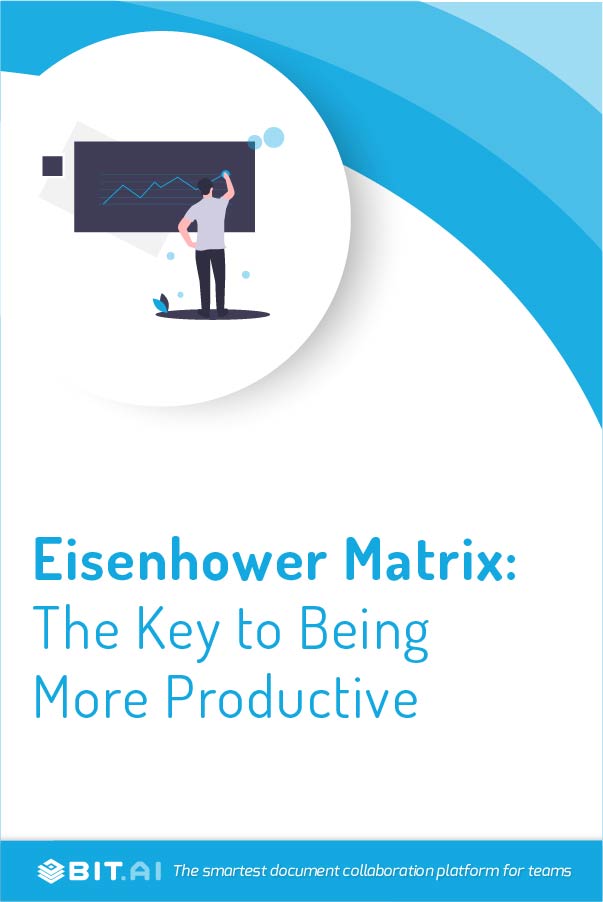Do you have a lot of tasks on your plate that needs to be completed in a short amount of time? No clue about where to begin, what to prioritize first, and how to declutter everything?
Well, you’re not alone. Modern life feels like an endless juggle of tasks to all of us. Work, family, relationships, exercise, relaxation, friends – it gets really hard to manage all the competing interests in our lives.
…and that’s exactly where the Eisenhower matrix comes in. It helps you prioritize effectively and efficiently, at work and at home. It makes you take a step back and ask: “Do I really need to do this?”
The Eisenhower Matrix helps in snuffing out the excess noise that your busy schedules throw at you, enabling you to focus on what matters the most. The result? A much more balanced workload, and a calmer mind!
Want to learn more about the Eisenhower Matrix, how it works and how to use it? Read on!
What Exactly is Eisenhower Matrix? (Definition)
The Eisenhower Matrix is a decision-making method that helps you identify and prioritize tasks based on urgency and importance. It is also known as Eisenhower Box, Urgent-Important Matrix, Time Management Matrix & Eisenhower Method.

This matrix helps you determine which tasks need to be completed right away, which tasks need to be delegated, and which ones need to be eliminated altogether.
In other words, The Eisenhower Matrix helps you become more effective and productive in your work. Using this method, you can avoid mindlessly working on multiple things for hours, and focus your efforts on the tasks that need it the most.
Now that you know what the Eisenhower Matrix is, let’s go back in time to learn where the term comes from. Buckle up, folks! You’re in for a ride.
Where Does The Term Come From?
Dwight D Eisenhower was the 34th President of the USA. Before that, he used to be a 5-Star General in the US Army. In a 1954 speech, Eisenhower quoted a university president who said:
I have two kinds of problems, the urgent and the important. The urgent are not important, and the important are never urgent.
Three decades later, Dr. Stephen Covey packaged Eisenhower’s insights on prioritization and published them in his book ‘The 7 Habits of Highly Effectively People’, and this framework for prioritization is now known worldwide as ‘The Eisenhower Matrix’.
Interesting back story, right? Let’s take a deep dive into something even more interesting – the four quadrants of the Eisenhower Matrix!
Read more: 13 Productivity Tools That Will Help You Achieve More in Less Time!
The 4 Quadrants of The Eisenhower Matrix
Quadrant 1: Do (Important & Urgent)
In this quadrant, you have to list tasks that are both urgent and important. These are ‘do first’ tasks, and they need to be finished soon as they’re critical for your life/career in some way. Basically, in order to avoid negative consequences, you need to complete these tasks right away.
For instance, replying to a time-sensitive email from your client or a medical emergency would be a part of Quadrant 1. Remember that you should be able to manage all the tasks in this quadrant effectively!
Quadrant 2: Schedule (Important, But Not Urgent)
The tasks in this quadrant would be important, but they don’t need to be accomplished immediately. These tasks are usually in line with your long-term plans. (Also, just because these tasks aren’t urgent, doesn’t mean that they are not important – but more about the difference between urgent and important later.)
For example, exercising is important to your health, right? But, you can decide when you want to exercise. Similarly, it’s important to spend time with your family, but that can be adjusted according to your schedule!
Quadrant 3: Delegate (Urgent, But Not Important)
How many times have you realized that you put too much effort into a task that wasn’t really important? How many times do you feel like something needs to be done right away – when it actually doesn’t?
Well, you are not the only one. We all end up making the common mistake of doing tasks that don’t directly benefit us or take us closer to our goals.
In this quadrant, you should list down things that you can delegate. For instance, if you are in the middle of an important project and your phone rings, it’s not really important for you to answer it. You can ask someone else to pick the phone up.
Some things which appear ‘urgent’ might actually just be a source of distraction. This includes checking your emails and phones and instantly responding to every message you receive!
Quadrant 4: Eliminate (Not Urgent & Not Important)
These tasks are simply time-wasters, and they should be eliminated completely. If you’re able to identify all your Quadrant 4 tasks and eliminate them, you will free up so much of your time that you could put into other tasks.
Playing videos game, binge-watching Netflix shows, scrolling through social media for hours, and browsing the web mindlessly are some of the examples of Quadrant 4 tasks.
No, this doesn’t mean that these activities shouldn’t be a part of your life. A little downtime is equally important as it helps you regain your energy. Just make sure that you spend little time on Quadrant 4 tasks, and you spend the most time on the Quadrant 2 tasks!
Good job! You’ve learned the most important aspect of the Eisenhower Matrix – the four quadrants. Let’s understand another important concept: the difference between urgent and important tasks.
Read more: Action Plan: Definition, Importance & How to Steps!
Urgent VS Important Tasks: What’s The Difference?
Urgent tasks are those tasks that are time-sensitive and need prompt attention. Whereas, important tasks are long-term and contribute to the bigger picture. They are usually done once the urgent tasks are completed.
It’s natural to be confused when it comes to deciding which tasks are ‘important’. To solve this problem, first, create a list of all the tasks that need to be completed, and then ask yourself: If this task couldn’t be completed, would there be significant repercussions?
Sometimes, urgent tasks blindside us so much that we start believing they are more important than they actually are. Remember that urgent tasks are not important just because they are time-sensitive!
We hope you can now differentiate between urgent and important tasks and create a solid Eisenhower Matrix. Now, let’s head over to the next section which will teach you how to balance the matrix!
How to Balance the Eisenhower Matrix?
First things first, balancing your Eisenhower Matrix does NOT mean that you should mention an equal number of tasks in each of the four quadrants. It’s about identifying which quadrant you want to spend the most time in.

By listing down all your monthly/weekly/daily tasks in the Eisenhower Matrix, you will be able to conjure up an image of where you’re spending the most time.
Ideally, you would be spending the most time on the quadrant where the to-do list is the longest, and the least time on Quadrant 3 & 4, i.ie, ‘not important and urgent tasks, and ‘not important and not urgent tasks.
Important: People often assume that most of their time should be spent in the ‘important and urgent quadrant. Yes, this isn’t a bad category to work in, but it can lead to stress and burnout.
The most productive category is actually the ‘important and not urgent’ quadrant. This category allows you to accomplish tasks – without overstraining yourself!
Do you want to learn some more amazing tips that will help you use the Eisenhower Matrix effectively? We know you do! Read on!
Six Awesome Tips for Using The Eisenhower Matrix
1. Color-Code Your Tasks
This tactic helps you visualize the high-priority tasks. As you go through your list of tasks, try setting color codes based on the priority level. For example:
- Green: Highest Priority Tasks (Quadrant 1)
- Yellow: Second-Highest Priority (Quadrant 2)
- Blue: Third-Highest Priority Tasks (Quadrant 3)
- Red: Not a Priority (Quadrant 4)
These color codes will help you figure out what needs to be done and when – just by taking a quick glance at the Eisenhower matrix!
2. Dedicate Certain Times For a Certain Responsibility
Here’s another hack to improve your Eisenhower Matrix: set a certain number of hours each day for activities in each quadrant. For instance, you can spend the first three hours of your day on Quadrant 1 (Important & Urgent), and a few hours a week on Quadrant 3 (Urgent, But Not Important).
3. Make Separate Personal & Professional To-Do Lists
Yes, you should create an Eisenhower Matrix for your personal and professional life. However, it’s best to create a separate matrix for both, so that you can limit the number of items on your to-do list and avoid overlapping commitments.
See, your work and personal tasks will obviously have different timelines, resources, and thought processes. So, in order to effectively achieve your personal and professional goals, you’ve to divide and conquer!
4. First Eliminate, Then Prioritize
To effectively prioritize your tasks, it’s always better to eliminate the unnecessary tasks first. That means, address Quadrant four before heading over to Quadrant one, two, and three.
As you go through your to-do list, assess what tasks you can scratch off. This will speed up the entire prioritization process, making you much more productive.
5. Limit Tasks to 10 Per Quadrant
If you have tons of tasks on your to-do list, we would recommend you limit the number of tasks to 10 per quadrant. The last thing you want is to make your Eisenhower Matrix cluttered and overwhelming! Adding too many tasks in each quadrant will make it overly complicated and lead to less productivity.
6. Break Large Projects into Smaller Ones
Let’s admit it – large projects seem daunting, and they often make us procrastinate. So, it’s better to divide your large projects into smaller ones. This way, you can accomplish the tasks easily and reduce stress!
Once you work on the small components of your project, you will realize that the seemingly large and intimidating project is complete, and everything was not as difficult as you expected!
Wrapping Up
Remember that prioritization is key. If you want to do more, you need to learn how to make better use of your time…and that’s exactly what the Eisenhower matrix helps you with.
An Eisenhower Matrix gives you a bird’s eye view of what needs to be accomplished, and helps you get rid of anything that isn’t in line with your long-term goals!
If you use Eisenhower Matrix the right way, you will set yourself up for success, stop hustling without a purpose and improve your productivity levels – without being burned out. ✨
Further reads:
How to Create a To-Do List the Most Effective Way! (Free Template)
11 Task Manager Apps You Must Know About!
10 Best Free Online To-Do List Apps to Help Improve Your Productivity!
Project Timeline: What is it & How to Create it? (Step By Step)
6 Workflow Tools and Apps for Smoother Processes!
9 Ways to Improve Work Performance in 2022



